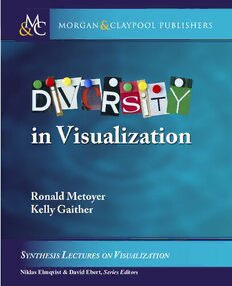
Diversity in Visualization PDF
Preview Diversity in Visualization
Series ISSN: 2159-516X M E T O Y E SyntheSiS LectureS on ViSuaLization R • G A I T Series Editors: Niklas Elmqvist,University of Maryland H E David Ebert, Purdue University R Diversity in Visualization Ronald Metoyer, University of Notre Dame Kelly Gaither, University of Texas at Austin At the 2016 IEEE Visualization Conference in Baltimore, Maryland, a panel of experts from the Scientific Visualization (SciVis) community gathered to discuss why the SciVis component of the conference had been D shrinking significantly for over a decade. As the panelists concluded and opened the session to questions from IV E the audience, Annie Preston, a Ph.D. student at the University of California, Davis, asked whether the panelists R thought diversity, or more specifically the lack of diversity, was a factor. S I T This comment ignited a lively discussion of diversity: not only its impact on Scientific Visualization, Y but also its role in the Visualization community at large. The goal of this book is to expand and organize the I N conversation. In particular, this book seeks to frame the diversity and inclusion topic within the Visualization V community, illuminate the issues, and serve as a starting point to address how to make this community more IS U diverse and inclusive. This book acknowledges that diversity is a broad topic with many possible meanings. A Expanded definitions of diversity that are relevant to the Visualization community and to computing at large are L I considered. The broader conversation of inclusion and diversity is framed within the broader sociological context Z A in which it must be considered. Solutions to recruit and retain a diverse research community and strategies for T I supporting inclusion efforts are presented. Additionally, community members present short stories detailing their O N “non-inclusive” experiences in an effort to facilitate a community-wide conversation surrounding very difficult situations. It is important to note that this is by no means intended to be a comprehensive, authoritative statement on the topic. Rather, this book is intended to open the conversation and begin to build a framework for diversity and inclusion in this specific research community. While intended for the Visualization community, ideally, this book will provide guidance for any computing community struggling with similar issues and looking for solutions. About SYNTHESIS M This volume is a printed version of a work that appears in the Synthesis O R Digital Library of Engineering and Computer Science. Synthesis G books provide concise, original presentations of important research and A N development topics, published quickly, in digital and print formats. & C L A Y P SyntheSiS LectureS on ViSuaLization O store.morganclaypool.com O L Niklas Elmqvist & David Ebert, Series Editors Diversity in Visualization Synthesis Lectures on Visualization Editors NiklasElmqvist,UniversityofMaryland DavidS.Ebert,PurdueUniversity SynthesisLecturesonVisualizationpublishes50-to100-pagepublicationsontopicspertainingto scientificvisualization,informationvisualization,andvisualanalytics.Potentialtopicsinclude,but arenotlimitedto:scientific,information,andmedicalvisualization;visualanalytics,applicationsof visualizationandanalysis;mathematicalfoundationsofvisualizationandanalytics;interaction, cognition,andperceptionrelatedtovisualizationandanalytics;dataintegration,analysis,and visualization;newapplicationsofvisualizationandanalysis;knowledgediscoverymanagementand representation;systems,andevaluation;distributedandcollaborativevisualizationandanalysis. DiversityinVisualization RonaldMetoyerandKellyGaither 2019 User-CenteredEvaluationofVisualAnalytics JeanScholtz 2017 InteractiveGPU-basedVisualizationofLargeDynamicParticleData MartinFalk,SebastianGrottel,MichaelKrone,andGuidoReina 2016 SemanticInteractionforVisualAnalytics:InferringAnalyticalReasoningforModel Steering AlexanderEndert 2016 DesignofVisualizationsforHuman-InformationInteraction:APattern-Based Framework KamranSedigandPaulParsons 2016 Image-BasedVisualization:InteractiveMultidimensionalDataExploration ChristopheHurter 2015 iii InteractionforVisualization ChristianTominski 2015 DataRepresentations,Transformations,andStatisticsforVisualReasoning RossMaciejewski 2011 AGuidetoVisualMulti-LevelInterfaceDesignFromSynthesisofEmpiricalStudy Evidence HeidiLamandTamaraMunzner 2010 Copyright©2019byMorgan&Claypool Allrightsreserved.Nopartofthispublicationmaybereproduced,storedinaretrievalsystem,ortransmittedin anyformorbyanymeans—electronic,mechanical,photocopy,recording,oranyotherexceptforbriefquotations inprintedreviews,withoutthepriorpermissionofthepublisher. DiversityinVisualization RonaldMetoyerandKellyGaither www.morganclaypool.com ISBN:9781681734934 paperback ISBN:9781681734941 ebook ISBN:9781681734958 hardcover DOI10.2200/S00894ED1V01Y201901VIS010 APublicationintheMorgan&ClaypoolPublishersseries SYNTHESISLECTURESONVISUALIZATION Lecture#9 SeriesEditors:NiklasElmqvist,UniversityofMaryland DavidS.Ebert,PurdueUniversity SeriesISSN Print2159-516X Electronic2159-5178 Diversity in Visualization Ronald Metoyer UniversityofNotreDame Kelly Gaither UniversityofTexasatAustin SYNTHESISLECTURESONVISUALIZATION#9 M &C Morgan &cLaypool publishers ABSTRACT At the 2016 IEEE VIS Conference in Baltimore, Maryland, a panel of experts from the Sci- entificVisualization(SciVis)communitygatheredtodiscusswhytheSciViscomponentofthe conference had been shrinking significantly for over a decade. As the panelists concluded and openedthesessiontoquestionsfromtheaudience,AnniePreston,aPh.D.studentattheUni- versityofCalifornia,Davis,askedwhetherthepaneliststhoughtdiversityor,morespecifically, thelackofdiversitywasafactor. This comment ignited a lively discussion of diversity: not only its impact on Scientific Visualization,butalsoitsroleinthevisualizationcommunityatlarge.Thegoalofthisbookis to expand and organize the conversation. In particular, this book seeks to frame the diversity and inclusion topic within the Visualization community, illuminate the issues, and serve as a starting point to address how to make this community more diverse and inclusive. This book acknowledgesthatdiversityisabroadtopicwithmanypossiblemeanings.Expandeddefinitions of diversity that are relevant to the Visualization community and to computing at large are considered. The broader conversation of inclusion and diversity is framed within the broader sociological context in which it must be considered. Solutions to recruit and retain a diverse researchcommunityandstrategiesforsupportinginclusioneffortsarepresented.Additionally, communitymemberspresentshortstoriesdetailingtheir“non-inclusive”experiencesinaneffort tofacilitateacommunity-wideconversationsurroundingverydifficultsituations. Itisimportanttonotethatthisisbynomeansintendedtobeacomprehensive,authori- tativestatementonthetopic.Rather,thisbookisintendedtoopentheconversationandbegin tobuildaframeworkfordiversityandinclusioninthisspecificresearchcommunity.Whilein- tended for the Visualization community, ideally, this book will provide guidance for any com- putingcommunitystrugglingwithsimilarissuesandlookingforsolutions. KEYWORDS diversity,inclusion,visualization vii Contents Editor’sNote ...................................................... xi Preface .......................................................... xiii Acknowledgments ................................................xvii 1 FramingtheConversation ............................................1 KellyGaitherandRonMetoyer 1.1 LoomingCrisis................................................... 1 1.2 MakingtheCase:ImportanceofaDiverseandInclusiveVisualization Community...................................................... 2 1.3 StateoftheField ................................................. 3 1.4 DefinitionsandScope ............................................. 4 2 Diversity:ASociologicalPerspective ...................................7 AvivaFrank 2.1 StructuralThinking ............................................... 7 2.2 Socialization ..................................................... 9 2.3 Oppression ...................................................... 9 2.4 Privilege/Disprivilege............................................. 12 2.5 Visualization:ACaseStudy ....................................... 13 2.6 NextSteps ..................................................... 14 3 FactorsHinderingDiversity .........................................15 KellyGaither 3.1 TheStraightLinefromDiversityandInclusiontoInnovation ............ 15 3.2 EntryBarriers................................................... 17 3.3 LeakyPipeline .................................................. 19 3.4 CommunityCulture.............................................. 20 viii 4 CaseStudies ......................................................23 Contributors:Anonymous;OrganizedbyMegPirrung 4.1 ImportanceofSharingExperiences.................................. 23 4.2 DescriptionandFramingofCaseStudies............................. 23 4.3 CaseStudy1.................................................... 24 4.4 CaseStudy2.................................................... 25 4.5 CaseStudy3.................................................... 27 4.6 CaseStudy4.................................................... 28 4.7 CaseStudy5.................................................... 29 5 CommunityOn-Ramps.............................................31 VetriaByrdandKellyGaither 5.1 BroadeningParticipationinVisualization(BPViz)Workshop ............ 31 5.1.1 SupportedActivities ........................................ 32 5.1.2 ParticipantRecruitment ..................................... 32 5.2 VisREUSite:CollaborativeDataVisualizationApplications ............. 33 5.3 AdvancedComputingforSocialChangeandComputing4Change ........ 35 6 Retention.........................................................39 RonMetoyer,ManuelPérezQuiñones,AnastasiaBezerianos,andJonathanWoodring 6.1 MentoringandCommunityBuilding—CriticalToolsofRetention ........ 39 6.2 TheCHIMentoring(CHIMe)Workshop ........................... 40 6.2.1 CHImeResults ............................................ 42 6.2.2 LessonsLearned ........................................... 43 6.2.3 VISMe:TheVisualizationMentoringWorkshop ................. 44 6.3 VisBuddies ..................................................... 45 6.3.1 MatchingProcessandResults ................................ 46 6.3.2 Outcomes ................................................ 46 6.3.3 FutureDirections .......................................... 50 6.3.4 DiversityandInclusion ...................................... 51 6.4 Conclusion ..................................................... 51 7 BuildingInclusiveCommunities .....................................53 Johanna Schmidt, Kelly Gaither, Mashhuda Glencross, Michelle Borkin, and Petra Isenberg 7.1 Introduction .................................................... 53
